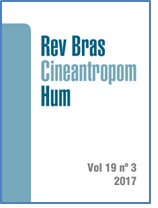Reproducibility and concurrent validity of the Physical Activity Questionnaire for Adolescents (QAFA) aged 10-14 years
DOI:
https://doi.org/10.1590/1980-0037.2017v19n3p270Abstract
The aim of the study was to evaluate the reproducibility and concurrent validity of the Physical Activity Questionnaire for Adolescents (QAFA). The reproducibility study (repeated evaluations with two-day interval between them) included 171 adolescents (average age 12.3 years, SD = 1.1), and the validity study (reference method: “Actgraph GT3X” accelerometer) included 341 adolescents (average age 11.9 years, SD = 1.0). All participants were students enrolled in public schools of Joao Pessoa (PB), Brazil. The QAFA reproducibility was measured using the intraclass correlation coefficient (ICC) and the Kappa PABAK Coefficient. Validity was evaluated by the Spearman correlation, Bland and Altman plot, sensitivity and specificity analysis. Reproducibility was satisfactory (ICC = 0.73; 95%CI: 0.63 - 0.79; Kappa PABAK = 0.58), and higher in physical activity frequency items (eight activities with ICC ? 0.70) than in duration items (seven activities with ICC ? 0.70). The correlation between QAFA and accelerometer was low (rho = 0.37; p < 0.001). Sensitivity was high (from 79.3% to 90.4%) and specificity was low (from 29.9% to 50.6%). The agreement between QAFA and accelerometer was satisfactory (Bland-Altman). QAFA showed satisfactory reproducibility and validity and can be used to evaluate physical activity in younger adolescents in face-to-face interviews.



